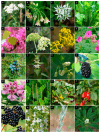Plants from Bulgarian Botanical Gardens: Some Selected Species with Potential for Health Food and Medical Applications
- PMID: 40733413
- PMCID: PMC12299724
- DOI: 10.3390/plants14142176
Plants from Bulgarian Botanical Gardens: Some Selected Species with Potential for Health Food and Medical Applications
Abstract
Bulgarian botanical gardens harbor more than 3600 plant species from across the world. Some of them are well-known plants widely used by humans, others are underutilized crops or little-known exotic species. The latter group constitutes a rich reservoir of plant resources whose potential to bring benefits to society is still untapped. The aim of this review is to describe the diversity of species and their potentially valuable secondary metabolites in three of the largest Bulgarian botanical gardens, with a focus on underutilized crops and medicinal plants that are typical of Bulgaria. With this, we aim to pave the way for future research on the most promising of these plants. The report includes currently available ethnobotanical data on the properties and composition of their bioactive components, known culinary or therapeutic uses, and nutritional profiles. We also outline the vast potential of these plants in providing healthy diets, as well as for performing future groundbreaking biomedical research. Finally, we present the approach that will be used to screen extracts from these plants for biological activity.
Keywords: botanical gardens; medicinal plants; secondary metabolites; underutilized crops.
Conflict of interest statement
The authors declare no conflicts of interest.
Figures





Similar articles
-
Systemic pharmacological treatments for chronic plaque psoriasis: a network meta-analysis.Cochrane Database Syst Rev. 2021 Apr 19;4(4):CD011535. doi: 10.1002/14651858.CD011535.pub4. Cochrane Database Syst Rev. 2021. Update in: Cochrane Database Syst Rev. 2022 May 23;5:CD011535. doi: 10.1002/14651858.CD011535.pub5. PMID: 33871055 Free PMC article. Updated.
-
Factors that influence parents' and informal caregivers' views and practices regarding routine childhood vaccination: a qualitative evidence synthesis.Cochrane Database Syst Rev. 2021 Oct 27;10(10):CD013265. doi: 10.1002/14651858.CD013265.pub2. Cochrane Database Syst Rev. 2021. PMID: 34706066 Free PMC article.
-
Home treatment for mental health problems: a systematic review.Health Technol Assess. 2001;5(15):1-139. doi: 10.3310/hta5150. Health Technol Assess. 2001. PMID: 11532236
-
The Black Book of Psychotropic Dosing and Monitoring.Psychopharmacol Bull. 2024 Jul 8;54(3):8-59. Psychopharmacol Bull. 2024. PMID: 38993656 Free PMC article. Review.
-
Systemic pharmacological treatments for chronic plaque psoriasis: a network meta-analysis.Cochrane Database Syst Rev. 2020 Jan 9;1(1):CD011535. doi: 10.1002/14651858.CD011535.pub3. Cochrane Database Syst Rev. 2020. Update in: Cochrane Database Syst Rev. 2021 Apr 19;4:CD011535. doi: 10.1002/14651858.CD011535.pub4. PMID: 31917873 Free PMC article. Updated.
References
-
- Faraji L., Karimi M. Botanical Gardens as Valuable Resources in Plant Sciences. Biodivers. Conserv. 2024;31:2905–2926. doi: 10.1007/s10531-019-01926-1. - DOI
Publication types
Grants and funding
LinkOut - more resources
Full Text Sources

